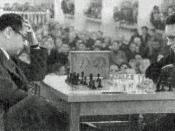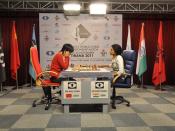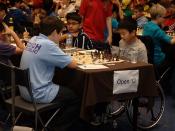The development of chess has a long and fascinating history. Its rules, pieces, strategies, players, and bureaucracies have evolved substantially throughout the centuries, and even millenniums. Observing the stylistic and strategic development of chess during the past century, the magnitude of change during a mere few years is both stunning and intriguing. After further investigation and analysis, it is apparent that there is a correlation between the games of the chess world and the social environment during the period. Since external influences from society implicitly change the styles of play in the Chess World Champions, hence also the chess world, what happens on the average chessboard during a certain time period, to some extent, reflects what the society is like during that period. A case study of this correlation will be done for the three World Champions who reigned right after the First World War and into the Second World War: Jose Capablanca, Alexandra Alekhine, and Mikhail Botvinnik.
Before examining specific cases, it is important to note that the majority of the chess world adopts the playing styles and techniques of the World Champion during the time. It is quite obvious that chess players who want to improve their play should imitate the best in the world, who supposedly have figured out the "strongest" way of playing chess from his own study of past World Champions and his own long history of winning records. In general, the moves of every match game or tournament the World Champion has competed in will be published for all to examine. Strong grandmasters would then analyze his games and write instructional books based on their discoveries from it for the public to read and learn. Thus, even though the public can never match the skills of the World Champion, everyone has the...



Wow I am pretty speechless
Very well done. I too am a Chess enthusiast and I really like the way you have incorporated your opinions regarding Chess as beneficial for society through such an indirect way seeing as how it is supposed to be written in third person. " Even the author of this paper, who is also a chess enthusiast, is not excluded from this trend of World Champion studying." Absolute genius. Excellent essay!
0 out of 0 people found this comment useful.